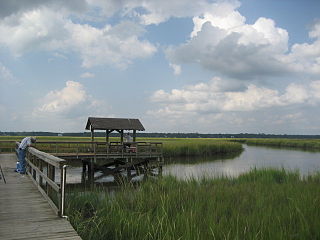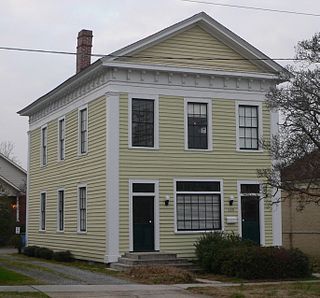
Ocracoke is a census-designated place (CDP) and unincorporated town located at the southern end of Ocracoke Island, located entirely within Hyde County, North Carolina, in the United States. The population was 948 as of the 2010 census. As of 2014, Ocracoke's population was estimated at 591. Ocracoke Island was the location of the pirate Blackbeard's death in November 1718.
Hermitage, The Hermitage or L'Hermitage may refer to:

Portsmouth was a fishing and shipping village located on Portsmouth Island on the Outer Banks in North Carolina. Portsmouth Island is a tidal island connected, under most conditions, to north end of the North Core Banks, across Ocracoke Inlet from the village of Ocracoke. The town lies in Carteret County, was established in 1753 by the North Carolina Colonial Assembly, and abandoned in 1971. Its remains are now part of the Cape Lookout National Seashore.

Hunting Island is a 5,000-acre (20 km2) secluded semitropical barrier island located 15 miles (24 km) east of Beaufort, South Carolina, United States in between Harbor Island and Fripp Island. Since 1935, it has been classified as a state park. It is the most-visited state park facility in South Carolina and is a part of the ACE Basin estuarine reserve area. Known for its natural environment, the island remains one of the few remaining undeveloped Sea Islands in the Lowcountry. The park is known for its 19th century lighthouse which bears its name. The park's beach has been featured in several travel publications and was listed in 2013 as a Top 25 beach in the United States by TripAdvisor.

The National Register of Historic Places in the United States is a register including buildings, sites, structures, districts, and objects. The Register automatically includes all National Historic Landmarks as well as all historic areas administered by the U.S. National Park Service. Since its introduction in 1966, more than 90,000 separate listings have been added to the register.

James Island is a town in Charleston County, South Carolina, United States. It is located in the central and southern parts of James Island. James Island is included within the Charleston-North Charleston-Summerville metropolitan area and the Charleston-North Charleston Urbanized Area.

Salt Fork State Park is a public recreation area located six miles (9.7 km) north of Lore City in Guernsey County, Ohio. It is the largest state park in Ohio, encompassing 17,229 acres (6,972 ha) of land and 2,952 acres (1,195 ha) of water. The grounds include the Kennedy Stone House, which is listed on the National Register of Historic Places. The park is managed by the Ohio Department of Natural Resources Division of Parks and Watercraft.

Paris Mountain State Park is a state park in the U.S. state of South Carolina, located five miles (8 km) north of Greenville. Activities available in the 1,540-acre (6 km2) park include hiking, biking, swimming and picnicking. The 13-acre (52,609 m2) Lake Placid offers swimming and fishing. Canoes, kayaks, and pedal boats are seasonally available for rental; private boats are not permitted. Camping is allowed and campsites range from rustic, back country sites to paved sites with water and electricity hook-ups. The park's Civilian Conservation Corps (CCC) structures, including the Camp Buckhorn lodge, are listed on the National Register of Historic Places. m.

The High Hampton Inn Historic District is a historic estate, resort, and national historic district nestled in the mountains of western North Carolina, in the Cashiers Valley in Jackson County, North Carolina. Originally the summer home of the prosperous Hampton family of South Carolina, the property was listed on the National Register of Historic Places in 1991.

The Manitou Lodge is a recreational building located on G Trail, on the grounds of the Hiawatha Sportman's Club, near Naubinway, Michigan. It was designated a Michigan State Historic Site in 1997 and listed on the National Register of Historic Places in 2011. It is about two miles from the Hiawatha Sportsman's Club 1931 Maintenance Building and Commissary, also on the grounds of the Hiawatha Sportsman's Club and listed on the National Register at the same time.

Botany Bay Plantation Wildlife Management Area is a state preserve on Edisto Island, South Carolina. Botany Bay Plantation was formed in the 1930s from the merger of the Colonial-era Sea Cloud Plantation and Bleak Hall Plantation. In 1977, it was bequeathed to the state as a wildlife preserve; it was opened to the public in 2008. The preserve includes a number of registered historic sites, including two listed in the National Register of Historic Places: a set of three surviving 1840s outbuildings from Bleak Hall Plantation, and the prehistoric Fig Island shell rings.

The Seashore Farmers' Lodge No. 767 is an historic building in coastal South Carolina that was erected to house a fraternal lodge for African-Americans. The Lodge was built about 1915 by local black farmers. Their organization provided insurance, advice, and burial assistance to members, and the structure was the headquarters for the outfit. In 1953, a new pavilion opened at nearby Mosquito Beach, and the Lodge fell into disuse.

The Aycock Birthplace, also known as the Charles B. Aycock Birthplace, is a historic home in Wayne County, North Carolina, and a historic site belonging to the North Carolina Department of Natural and Cultural Resources' Historic Sites division. The property was the location of the birth of Governor Charles Brantley Aycock in 1859, and exhibits at the historic site serve to tell the story of the Governor's political career and the education reforms he enacted while in office. It was built about 1840, and is a one-story weatherboard dwelling on a brick pier foundation. It has a gable roof and exterior end chimneys.

The Hall Cabin, also known as the J. H. Kress Cabin is a historic log cabin in Great Smoky Mountains National Park, about 15 miles (24 km) from Fontana, North Carolina. The cabin is a rectangular split-log structure 24 feet (7.3 m) wide and 17 feet (5.2 m) deep, with a porch spanning its front. The gable ends of the roof are sheathed in board-and-batten siding. It was built by a man named Hall in 1910, and underwent some remodeling around 1940 when J. H. Kress used it as a hunting lodge. It is located in the drainage of Hazel Creek, an area which historically had a small population and was abandoned after the construction of Fontana Lake and the national park. It is the only structure remaining in its immediate vicinity.

E. M. Backus Lodge, also known as Camp Toxaway, The Cold Mountain Lodge and Canaan Land Christian Retreat , is a historic hunting lodge and national historic district located near Lake Toxaway, Jackson County and Transylvania County, North Carolina. The lodge was built about 1903, and is a 2-story, double-pile house of chestnut logs. The lodge contains eight rooms on two floors, each grouped around a central hall. Also on the property are the contributing log stable, caretaker's cottage, guest cottage, barn, and Davis Cottage. The site was the former hunting lodge of Thomas Edison, Henry Ford and Harvey Firestone. The camp became an exclusive girls' camp, Camp Toxaway, in 1922, and a religious and educational retreat in 1955 known as Canaan Land.The estate was bought by George and Nancy Corbett of Florida in 1986 and is still operated by the Corbett family.

Smithfield Masonic Lodge, also known as the Brooks Building, is a historic Masonic Lodge located at Smithfield, Johnston County, North Carolina, United States It is believed to be built in about 1854, and had moved to its present location in 1915–1917. It is a two-story, three bay, rectangular vernacular Greek Revival style frame building. It has a gable front temple form and is sheathed in plain weatherboard. Fellowship Lodge No. 84 occupied the building until the 1940s, and the Smithfield Woman's Club met in the building from 1917 through 1933. The building house Smithfield's first public library operated by the Smithfield Woman's Club.

The Maine Woods Office, now the Phillips Community Building, is a historic commercial and community building on Main Street in Phillips, Maine. Built in 1848 by a local lawyer, it is regionally significant as a rare example of commercial Gothic Revival architecture, and as the original home of the Maine Woods newspaper, which disseminated news about sporting and hunting in Maine to an international audience. The building was listed on the National Register of Historic Places in 1980.

Holly Springs Masonic Lodge is a historic Masonic Lodge located at Holly Springs, Wake County, North Carolina. It was built about 1852, and is a two-story, Greek Revival influenced frame building with a side gable roof. It has a one-story, hip roofed front porch. In addition to being a Masonic Lodge, the building also housed a school.

The Flyway Club is a historic shooting club at 221 Marsh Causeway in Knotts Island, North Carolina. Located on more than 400 acres (160 ha) facing Currituck Sound on the west side of Knotts Island, it is one of the oldest surviving fowl hunting clubs in the state. Its main lodge was built about 1920, and rebuilt in a near replica in 1960 after being destroyed by fire. The lodge also includes a large U-shaped farm building, also built about 1920, that housed the club staff and farming equipment. The club was established by Ogden Mills Reid, and remained in the Reid family until 2013, when it was acquired by the Conservation Fund.

Urbauer Fishing Lodge Historic District, also known as the Mozark Club and Windsor Estates Mental Health Facility, is a national historic district located at Fulton, Callaway County, Missouri. It encompasses five contributing buildings, one contributing site, and one contributing structure constructed by St. Louis industrialist Hugo Urbauer as a private fishing retreat. It was developed about 1930, and includes the main lodge, a Bungalow style house, a seven-vehicle garage, pumphouse, a set of 83 concrete stairs leading down to the Niangua River, and a small concrete storage building. The main lodge is a one- to two-story building constructed of sandstone, limestone and cinderblock. It as a gable roof with wide overhanging eaves.





















